Horse Racing History
The competitive racing of horses is one of humankind's most ancient sports, having its origins among the prehistoric nomadic tribesmen of Central Asia who first domesticated the horse about 4500 BC. For thousands of years, horse racing flourished as the sport of kings and the nobility. Modern racing, however, exists primarily because it is a major venue for legalized gambling.
Horse racing is the second most widely attended U.S. spectator sport, after baseball. In 1989, 56,194,565 people attended 8,004 days of racing, wagering $9.14 billion. Horse racing is also a major professional sport in Canada, Great Britain, Ireland, Western Europe, Australia, New Zealand, South Africa, and South America.
By far the most popular form of the sport is the racing of mounted thoroughbred horses over flat courses at distances from three-quarters of a mile to two miles. Other major forms of horse racing are harness racing, steeplechase racing, and quarter horse racing.
Thoroughbred Racing
By the time humans began to keep written records, horse racing was an organized sport in all major civilizations from Central Asia to the Mediterranean. Both chariot and mounted horse racing were events in the ancient Greek Olympics by 638 BC, and the sport became a public obsession in the Roman Empire.
The origins of modern racing lie in the 12th century, when English knights returned from the Crusades with swift Arab horses. Over the next 400 years, an increasing number of Arab stallions were imported and bred to English mares to produce horses that combined speed and endurance. Matching the fastest of these animals in two-horse races for a private wager became a popular diversion of the nobility.
Horse racing began to become a professional sport during the reign (1702-14) of Queen Anne, when match racing gave way to races involving several horses on which the spectators wagered. Racecourses sprang up all over England, offering increasingly large purses to attract the best horses. These purses in turn made breeding and owning horses for racing profitable. With the rapid expansion of the sport came the need for a central governing authority. In 1750 racing's elite met at Newmarket to form the Jockey Club, which to this day exercises complete control over English racing.
The Jockey Club wrote complete rules of racing and sanctioned racecourses to conduct meetings under those rules. Standards defining the quality of races soon led to the designation of certain races as the ultimate tests of excellence. Since 1814, five races for three-year-old horses have been designated as "classics." Three races, open to male horses (colts) and female horses (fillies), make up the English Triple Crown: the 2,000 Guineas, the Epsom Derby (see DERBY, THE), and the St. Leger Stakes. Two races, open to fillies only, are the 1,000 Guineas and the Epsom Oaks.
The Jockey Club also took steps to regulate the breeding of racehorses. James Weatherby, whose family served as accountants to the members of the Jockey Club, was assigned the task of tracing the pedigree, or complete family history, of every horse racing in England. In 1791 the results of his research were published as the Introduction to the General Stud Book. From 1793 to the present, members of the Weatherby family have meticulously recorded the pedigree of every foal born to those racehorses in subsequent volumes of the General Stud Book. By the early 1800s the only horses that could be called "Thoroughbreds" and allowed to race were those descended from horses listed in the General Stud Book. Thoroughbreds are so inbred that the pedigree of every single animal can be traced back father-to-father to one of three stallions, called the "foundation sires." These stallions were the Byerley Turk, foaled c.1679; the Darley Arabian, foaled c.1700; and the Godolphin Arabian, foaled c.1724.
American Thoroughbred Racing
The British settlers brought horses and horse racing with them to the New World, with the first racetrack laid out on Long Island as early as 1665. Although the sport became a popular local pastime, the development of organized racing did not arrive until after the Civil War. (The American Stud Book was begun in 1868.) For the next several decades, with the rapid rise of an industrial economy, gambling on racehorses, and therefore horse racing itself, grew explosively; by 1890, 314 tracks were operating across the country.
The rapid growth of the sport without any central governing authority led to the domination of many tracks by criminal elements. In 1894 the nation's most prominent track and stable owners met in New York to form an American Jockey Club, modeled on the English, which soon ruled racing with an iron hand and eliminated much of the corruption.
In the early 1900s, however, racing in the United States was almost wiped out by antigambling sentiment that led almost all states to ban bookmaking. By 1908 the number of tracks had plummeted to just 25. That same year, however, the introduction of pari-mutuel betting for the Kentucky Derby signaled a turnaround for the sport. More tracks opened as many state legislatures agreed to legalize pari-mutuel betting in exchange for a share of the money wagered. At the end of World War I, prosperity and great horses like Man o' War brought spectators flocking to racetracks. The sport prospered until World War II, declined in popularity during the 1950s and 1960s, then enjoyed a resurgence in the 1970s triggered by the immense popularity of great horses such as Secretariat, Seattle Slew, and Affirmed, each winners of the American Triple Crown--the KENTUCKY DERBY, the Preakness, and the Belmont Stakes. During the late 1980s, another significant decline occurred, however.
Thoroughbred tracks exist in about half the states. Public interest in the sport focuses primarily on major Thoroughbred races such as the American Triple Crown and the Breeder's Cup races (begun in 1984), which offer purses of up to about $1,000,000. State racing commissions have sole authority to license participants and grant racing dates, while sharing the appointment of racing officials and the supervision of racing rules with the Jockey Club. The Jockey Club retains authority over the breeding of Thoroughbreds.
Breeding
Although science has been unable to come up with any breeding system that guarantees the birth of a champion, breeders over the centuries have produced an increasingly higher percentage of Thoroughbreds who are successful on the racetrack by following two basic principles. The first is that Thoroughbreds with superior racing ability are more likely to produce offspring with superior racing ability. The second is that horses with certain pedigrees are more likely to pass along their racing ability to their offspring.
Male Thoroughbreds (stallions) have the highest breeding value because they can mate with about 40 mares a year. The worth of champions, especially winners of Triple Crown races, is so high that groups of investors called breeding syndicates may be formed. Each of the approximately 40 shares of the syndicate entitles its owner to breed one mare to the stallion each year. One share, for a great horse, may cost several million dollars. A share's owner may resell that share at any time.
Farms that produce foals for sale at auction are called commercial breeders. The most successful are E. J. Taylor, Spendthrift Farms, Claiborne Farms, Gainsworthy Farm, and Bluegrass Farm, all in Kentucky. Farms that produce foals to race themselves are called home breeders, and these include such famous stables as Calumet Farms, Elmendorf Farm, and Green-tree Stable in Kentucky and Harbor View Farm in Florida.
Betting
Wagering on the outcome of horse races has been an integral part of the appeal of the sport since prehistory and today is the sole reason horse racing has survived as a major professional sport.
All betting at American tracks today is done under the pari-mutuel wagering system, which was developed by a Frenchman named Pierre Oller in the late 19th century. Under this system, a fixed percentage (14 percent-25 percent) of the total amount wagered is taken out for track operating expenses, racing purses, and state and local taxes. The remaining sum is divided by the number of individual wagers to determine the payoff, or return on each bet. The projected payoff, or "odds," are continuously calculated by the track's computers and posted on the track odds board during the betting period before each race. Odds of "2-1," for example, mean that the bettor will receive $2 profit for every $1 wagered if his or her horse wins.
At all tracks, bettors may wager on a horse to win (finish first), place (finish first or second), or show (finish first, second, or third). Other popular wagers are the daily double (picking the winners of two consecutive races), exactas (picking the first and second horses in order), quinellas (picking the first and second horses in either order), and the pick six (picking the winners of six consecutive races).
Handicapping
The difficult art of predicting the winner of a horse race is called handicapping. The process of handicapping involves evaluating the demonstrated abilities of a horse in light of the conditions under which it will be racing on a given day. To gauge these abilities, handicappers use past performances, detailed published records of preceding races. These past performances indicate the horse's speed, its ability to win, and whether the performances tend to be getting better or worse. The conditions under which the horse will be racing include the quality of the competition in the race, the distance of the race, the type of racing surface (dirt or grass), and the current state of that surface (fast, sloppy, and so on). The term handicapping also has a related but somewhat different meaning: in some races, varying amounts of extra weight are assigned to horses based on age or ability in order to equalize the field.
Harness Racing
The racing of horses in harness dates back to ancient times, but the sport virtually disappeared with the fall of the Roman Empire. The history of modern HARNESS RACING begins in America, where racing trotting horses over country roads became a popular rural pastime by the end of the 18th century. The first tracks for harness racing were constructed in the first decade of the 19th century, and by 1825 harness racing was an institution at hundreds of country fairs across the nation.
With the popularity of harness racing came the development of the STANDARDBRED, a horse bred specifically for racing under harness. The founding sire of all Standardbreds is an English Thoroughbred named Messenger, who was brought to the United States in 1788. Messenger was bred to both pure Thoroughbred and mixed breed mares, and his descendants were rebred until these matings produced a new breed with endurance, temperament, and anatomy uniquely suited to racing under harness. This new breed was called the Standardbred, after the practice of basing all harness-racing speed records on the "standard" distance of one mile.
Harness racing reached the early zenith of its popularity in the late 1800s, with the establishment of a Grand Circuit of major fairs. The sport sharply declined in popularity after 1900, as the automobile replaced the horse and the United States became more urbanized. In 1940, however, Roosevelt Raceway in New York introduced harness racing under the lights with pari-mutuel betting. This innovation sparked a rebirth of harness racing, and today its number of tracks and number of annual races exceed those of Thoroughbred racing. The sport is also popular in most European countries, Canada, New Zealand, and Australia.
Steeplechase, Hurdle, and Point-To-Point Racing
Steeplechases are races over a 2- to 4-mi (3.2- to 6.4-km) course that includes such obstacles as brush fences, stone walls, timber rails, and water jumps. The sport developed from the English and Irish pastime of fox hunting, when hunters would test the speed of their mounts during the cross-country chase. Organized steeplechase racing began about 1830, and has continued to be a popular sport in England to this day. The most famous steeplechase race in the world is England's Grand National, held every year since 1839 at Aintree. Steeplechase racing is occasionally conducted at several U.S. Thoroughbred race tracks. The most significant race is the U.S. Grand National Steeplechase held yearly at Belmont Park.
Hurdling is a form of steeplechasing that is less physically demanding of the horses. The obstacles consist solely of hurdles 1 to 2 ft (0.3 to 0.6 m) lower than the obstacles on a steeplechase course, and the races are normally less than 2 mi in length. Hurdling races are often used for training horses that will later compete in steeplechases. Horses chosen for steeplechase training are usually Thoroughbreds selected for their endurance, calm temperament, and larger-than-normal size.
Point-to-point races are held for amateurs on about 120 courses throughout the British Isles. Originally run straight across country (hence the name), these races are now conducted on oval tracks with built-in fences, often on farmland.
Horse Racing Spotlight
- THE TRIPLE CROWN This is the pinnacle of horse racing achievements. It requires winning three of the biggest stakes races in the world, all within a five-week stretch that starts on the first Saturday of May.
- THE KENTUCKY DERBY This is the first jewel of the Triple Crown. It is staged at Churchill Downs in Louisville, Kentucky on the first Saturday in May, capping the two-week-long Kentucky Derby Festival.
- THE PREAKNESS STAKES This the middle jewel of the Triple Crown. It was conceived through an agreement among sportsmen to stage a special race to commemorate a memorable occasion on a late summer evening in 1868.
- THE BELMONT STAKES This is the third jewel of the Triple Crown. It is held five weeks after the Kentucky Derby at Belmont Park in Elmont, New York.
- THE BREEDERS' CUP This is a one-day event held at a location that changes each year. All the sites have been in the United States, except in 1996, when the races were held at Woodbine Racetrack in Canada.

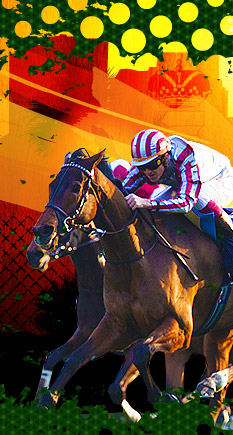
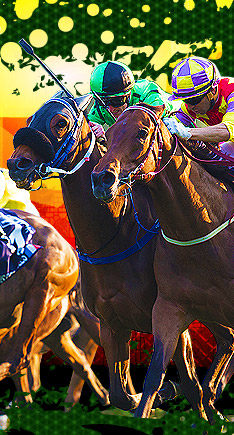
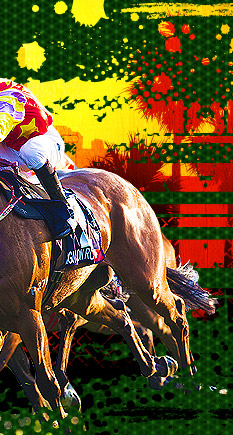
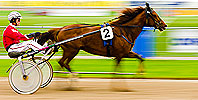 Harness Racing Generally speaking, the inside post positions (numbers one through four) are an advantage, especially on half-mile tracks.
Harness Racing Generally speaking, the inside post positions (numbers one through four) are an advantage, especially on half-mile tracks.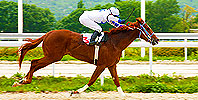 Thoroughbred Racing "Pace makes the race." This old racing expression points to another element to consider when placing your bets -- the pace of the race.
Thoroughbred Racing "Pace makes the race." This old racing expression points to another element to consider when placing your bets -- the pace of the race.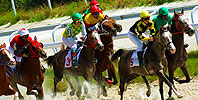 Quarter Horse Racing Straightaway American Quarter Horse racing is an all-out burst of speed from the starting gate with every horse trying to put a head in front at the finish.
Quarter Horse Racing Straightaway American Quarter Horse racing is an all-out burst of speed from the starting gate with every horse trying to put a head in front at the finish.